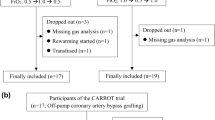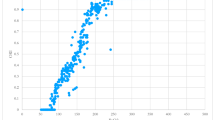Abstract
The relationships between oxygen delivery (DO2), oxygen consumption (VO2), and the extraction rate (ER=VO2/DO2x100) in patients undergoing cardiopulmonary bypass (CPB) may differ from the normal physiologic state due to the oxygen debt acquired during CPB. Blood gas analysis and hemodynamic parameters were repeatedly measured for the determination of DO2 and VO2 in 40 patients undergoing CPB, every 8h during the first 48h postoperatively. As a control, 20 patients who had suffered acute myocardial infarction (AMI) were also studied using the same protocol. In the CPB group, a regression analysis showed that VO2 was significantly dependent on DO2, even within the physiologic range of DO2 (>500 ml/min per m2); VO2=121.4+0.0844×DO2 (r=0.254,P=0.023). Conversely, in the AMI group, no such supply-dependent consumption was observed within the same range of DO2. At an ER of 30%, which is the optimal value in general, the DO2 of the CPB group was 575 ml/min per m2 and that of the AMI group was 493 ml/min per m2. All these results suggest that patients undergoing CPB need a much higher oxygen supply to recover from the oxygen debt acquired during open heart surgery.
Similar content being viewed by others
References
Schumacker PT, Cain SM (1987) The concept of a critical oxygen delivery. Intens Care Med 13:223–229
Buran MJ (1987) Oxygen consumption. In: Snyder JV (ed) Oxygen transport in the critically ill. Year Book Medical, Chicago, pp 16–21
Wood LDH (1992) Gas transport between the lungs and body tissue. In: Hall JB, Schmidt GA, Wood LDH, (eds) Principles of critical care. McGraw-Hill, New York, pp 3–9
Shoemaker WC (1987) Relationship of oxygen transport patterns to the pathophysiology and therapy of shock states. Intens Care Med 13:230–243
Pepe PE, Culver BH (1985) Independently measured oxygen consumption during reduction of oxygen delivery by positive end-expiratory pressure. Am Rev Respir Dis 132:788–792
Shibutani K, Komatsu T, Kubal K, Sanchala V, Kumar V, Bizzarri DV (1983) Critical level of oxygen delivery in anesthetized man. Crit Care Med 11:640–643
Komatsu T, Shibutani K, Okamoto K, Kumar V, Kubal K, Sanchala V, Lees DE (1987) Critical level of oxygen delivery after cardiopulmonary bypass. Crit Care Med 15:194–197
Fox LS, Blackstone EH, Kirklin JW, Stewart RW, Samuelson PN (1982) Relationship of whole body oxygen consumption to perfusion flow rate during hypothermic cardiopulmonary bypass. J Thorac Cardiovasc Surg 83:239–248
Hickey RF, Hoar PF (1983) Whole-body oxygen consumption during low-flow hypothermic cardiopulmonary bypass. J Thorac Cardiovasc Surg 86:903–906
Alpert NR, Kayne H, Haslett W (1958) Relationship among recovery oxygen, oxygen missed, lactate production and lactate removal during and following severe hypoxia in the unanesthetized dog. Am J Physiol 192:585–591
Author information
Authors and Affiliations
Rights and permissions
About this article
Cite this article
Utoh, J., Moriyama, S., Okamoto, K. et al. The effects of cardiopulmonary bypass on postoperative oxygen metabolism. Surg Today 29, 28–33 (1999). https://doi.org/10.1007/BF02482966
Received:
Accepted:
Issue Date:
DOI: https://doi.org/10.1007/BF02482966




